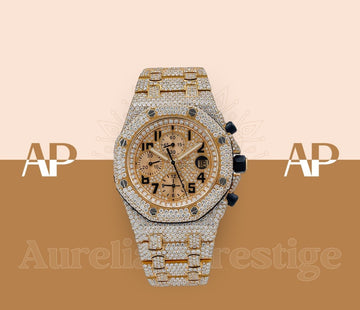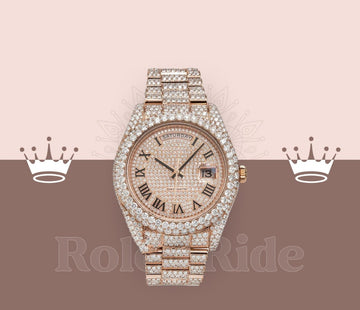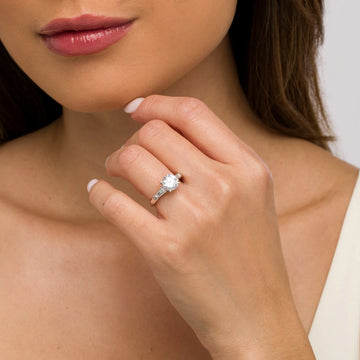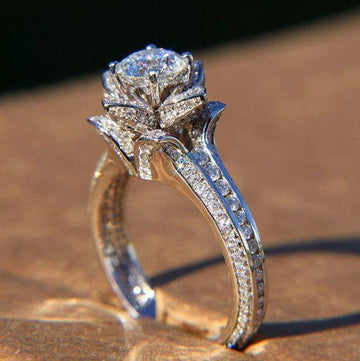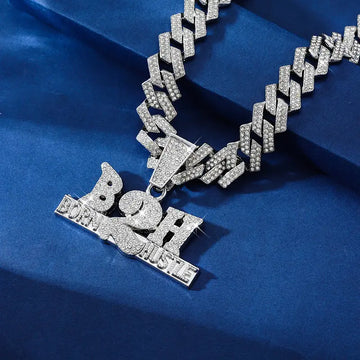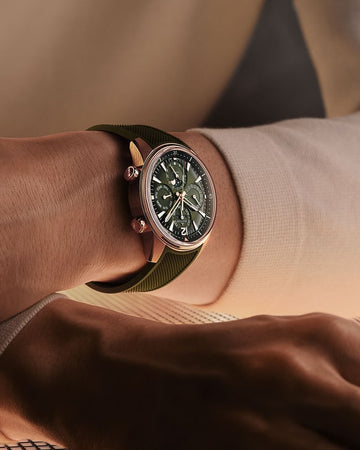
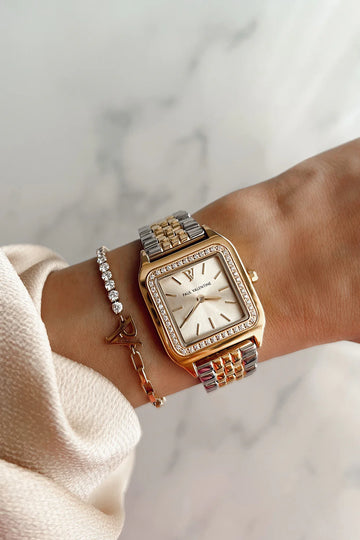
Watch Bracelets: Style, Comfort & Durability
A watch bracelet is more than just a functional strap—it enhances the style, comfort, and durability of your timepiece. From the iconic Oyster bracelet known for its strength to the luxurious President bracelet, each type offers a unique aesthetic and feel. Jubilee bracelets provide elegance, while integrated bracelets blend seamlessly with the watch case. Materials range from stainless steel and titanium to gold and platinum, ensuring both durability and luxury. Understanding different bracelet styles, materials, and maintenance tips helps you choose the perfect bracelet for your watch, ensuring both comfort and longevity in your everyday wear.
Different Types of Watch Bracelets
Watch bracelets come in various styles, each offering a unique look and feel. Common types include the Oyster bracelet, known for durability; the Jubilee bracelet, featuring a five-link design for elegance; the President bracelet, offering luxury with semi-circular links; the Milanese mesh, providing a sleek, flexible fit; and the integrated bracelet, seamlessly blending into the watch case.
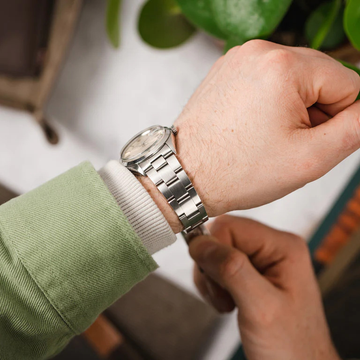
Oyster Bracelets
The Oyster bracelet is one of the most recognizable and enduring metal watch bracelets, first introduced in the 20th century. Over the decades, its design has evolved, incorporating solid links and a robust clasp for enhanced durability and a secure fit on the wrist.
What makes the Oyster bracelet so popular is its signature central bar, which reinforces the links and minimizes stretching over time. This ensures long-lasting durability, making it a preferred choice for watch enthusiasts. Its sleek yet sturdy design allows it to pair seamlessly with a wide range of watches, from sporty to elegant timepieces.
Beyond aesthetics, the Oyster bracelet offers exceptional comfort and resilience, making it a reliable option for daily wear. Whether you prefer a bold or minimalist look, this bracelet is a timeless choice.
Explore our wide selection of Oyster bracelets to find the perfect fit for your watch and style.

President Bracelet
The President bracelet is a symbol of luxury and refinement, first introduced in 1956. Designed exclusively for high-end watches, it features a distinctive three-piece semi-circular link design that blends sophistication with exceptional comfort. This unique structure ensures a seamless fit around the wrist, making it one of the most elegant and sought-after bracelets in the watch industry.
Crafted with premium materials such as gold or platinum, the President bracelet is known for its polished center links and brushed outer links, striking the perfect balance between brilliance and subtlety. Its refined aesthetic makes it an ideal choice for formal occasions while maintaining a timeless appeal for everyday wear.
Beyond its luxurious design, the President bracelet is engineered for durability and security, featuring a concealed Crownclasp that enhances its sleek look while providing a secure closure. This bracelet is a hallmark of exclusivity, often associated with some of the most prestigious timepieces.
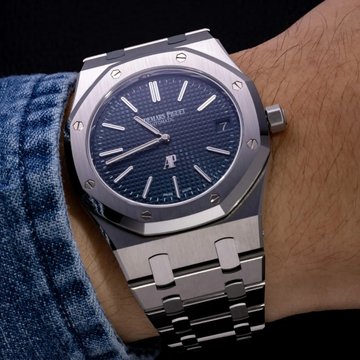
Integrated Bracelet
An integrated bracelet is seamlessly designed as part of the watch case, eliminating traditional lugs and blending smoothly into the first link. This creates a cohesive, flowing aesthetic, making it a highly desirable feature in modern luxury watches.
One of the most iconic examples is Gérald Genta’s 1972 design for the Audemars Piguet Royal Oak, featuring a tapered bracelet with large single links connected by two rows of metal studs, finished with alternating brushed and polished surfaces. In 1976, Genta refined the concept with the Patek Philippe Nautilus, introducing H-shaped links flanking large central links, creating a distinctive contrast.
These designs have inspired countless luxury models, including the Vacheron Constantin Overseas, Tissot PRX, and Girard-Perregaux Laureato. The integrated bracelet remains a defining feature of the sport-luxury watch genre, offering both a refined aesthetic and superior comfort, making it a top choice among watch enthusiasts worldwide.
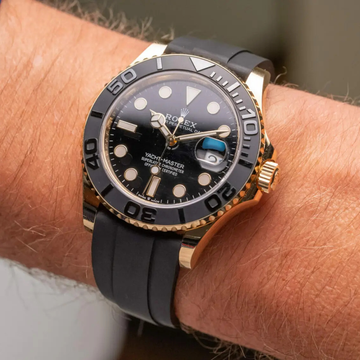
Oysterflex Bracelet
Introduced in 2015, the Oysterflex bracelet is an exclusive Rolex innovation that combines the durability of a metal bracelet with the comfort of a rubber strap. Unlike traditional rubber straps, the Oysterflex features a patented “longitudinal cushion” system, consisting of titanium and nickel-alloy blades encased in black elastomer. This unique construction provides exceptional flexibility, strength, and stability, ensuring a secure yet comfortable fit.
First appearing on the Rolex GMT-Master in Everose Gold, the Oysterflex bracelet quickly gained recognition for its sporty yet refined aesthetic. Unlike conventional rubber straps, it maintains the rigidity of a metal bracelet, making it highly resistant to deformation over time.
Despite its rubberized exterior, the Oysterflex remains exclusively a Rolex design, with no other brands replicating its advanced construction. Its blend of durability, luxury, and comfort makes it a standout choice for high-performance sports watches and luxury timepieces alike.
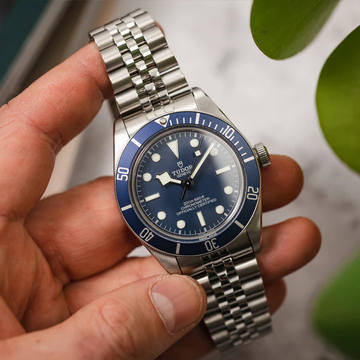
Jubilee Bracelet
The Jubilee bracelet is a timeless and elegant watch bracelet, first introduced by Rolex in 1945 for the launch of the Datejust collection. Known for its five-piece link construction, it features three narrow, polished center links flanked by two broader, brushed outer links. This combination of finishes creates a refined, luxurious aesthetic, making the Jubilee bracelet a popular choice for both dress and sports watches.
Designed for comfort and flexibility, the Jubilee bracelet conforms seamlessly to the wrist, offering a smooth, lightweight feel. Its intricate design enhances not only aesthetics but also durability, making it resistant to stretching over time.
The hidden Crownclasp or Oysterclasp secures the bracelet while maintaining its sleek appearance. While initially exclusive to the Datejust, the Jubilee bracelet has since been adapted for various Rolex models and remains a favorite among collectors. Its blend of sophistication and comfort ensures its lasting appeal in the watch industry.
Watch Bracelet Materials: Strength, Style & Versatility
Watch bracelets are crafted from stainless steel, titanium, gold, platinum, and two-tone metals, offering durability, elegance, and comfort. Each material enhances the watch’s aesthetic, longevity, and functionality.
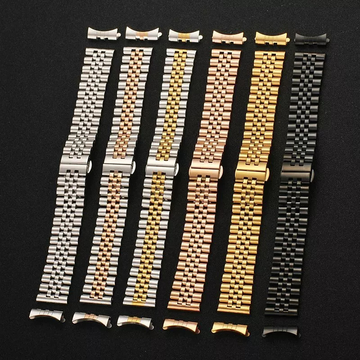
The material of a watch bracelet plays a crucial role in its durability, aesthetics, and comfort. Stainless steel is the most popular choice, offering strength, corrosion resistance, and affordability. Titanium is lighter than steel yet equally strong, making it ideal for sporty and luxury watches. Gold and platinum bracelets exude prestige and elegance, commonly found in high-end timepieces, but require more maintenance due to their softer nature. Two-tone metal bracelets, combining gold and steel, offer a balance of luxury and durability. Mesh (Milanese) bracelets provide a vintage, flexible feel, while integrated bracelets blend seamlessly with the watch case for a modern look. Oysterflex bracelets, featuring a metal core wrapped in elastomer, deliver a mix of comfort and durability. Choosing the right bracelet material ensures a perfect balance of style, resilience, and versatility, enhancing the watch’s overall appeal and wearability.
More Guide
Frequently Ask Question
What are the different movements in watches?
Watches typically feature three main types of movements: manual, automatic, and quartz. Manual movements require daily winding and are known for their traditional craftsmanship. Automatic movements self-wind through the wearer’s wrist motion, offering convenience without daily winding. Quartz movements, powered by a battery, provide superior accuracy and require minimal maintenance. Additionally, hybrid movements like kinetic and solar combine mechanical and quartz elements for enhanced functionality.
Which movement is best for watch?
The best movement depends on personal preferences. Manual movements are ideal for traditionalists who enjoy daily winding. Automatic movements offer convenience through self-winding. Quartz movements are perfect for those who prioritize accuracy and low maintenance. Each type has its advantages, and the choice depends on whether you value heritage, convenience, or precision in your timepiece.
How does a quartz movement work?
Quartz movements use a battery to send an electrical current through a quartz crystal, which oscillates at a consistent frequency. This ensures highly accurate timekeeping with minimal maintenance.
Which type of motion is watch?
Watches utilize either mechanical or electronic motion. Mechanical watches, including manual and automatic, operate through gears and springs. Quartz watches use electronic motion, powered by a battery and a quartz crystal. Mechanical movements create a consistent ticking motion, while quartz movements offer high accuracy through precise vibrations.
How to choose a watch movement?
Choosing a watch movement involves considering your lifestyle and preferences. Manual movements suit those who appreciate traditional craftsmanship. Automatic movements are convenient, self-winding through wrist motion. Quartz movements prioritize accuracy and low maintenance. Consider factors like budget and desired features to select the best movement for your needs.
Which watch movement is most accurate?
Quartz movements are the most accurate, powered by a battery and a vibrating quartz crystal. They lose or gain only a few seconds per month. In contrast, mechanical movements, including manual and automatic, have variations of several seconds per day. Quartz watches are preferred for their superior accuracy.
What movement do luxury watches use?
Luxury watches predominantly use mechanical movements, including manual and automatic, due to their intricate craftsmanship. High-end brands often develop in-house movements, ensuring exclusivity and superior quality. While quartz movements are less common, some luxury brands offer high-end quartz models for unparalleled accuracy.
Which is better, quartz or automatic watch?
The choice between quartz and automatic watches depends on preferences. Quartz watches are highly accurate, low-maintenance, and affordable, requiring only periodic battery changes. Automatic watches are cherished for their craftsmanship and heritage, self-winding through wrist motion. Choose quartz for precision and convenience, automatic for traditional mechanical appeal.
Which watch movement is more expensive?
Mechanical movements, including manual and automatic, are generally more expensive than quartz movements due to intricate craftsmanship and complex engineering. Brands that develop in-house movements command premium prices. Quartz movements are simpler and cheaper to produce, making quartz watches more affordable, though high-end quartz models can be expensive.
How to tell if a watch is automatic?
To identify an automatic watch, observe the second hand’s smooth, sweeping motion, unlike the ticking motion of quartz watches. Check if the watch self-winds with wrist motion. Many automatic watches have a transparent case back to view the movement. Listen for a continuous ticking sound, different from quartz watches’ distinct ticks.






